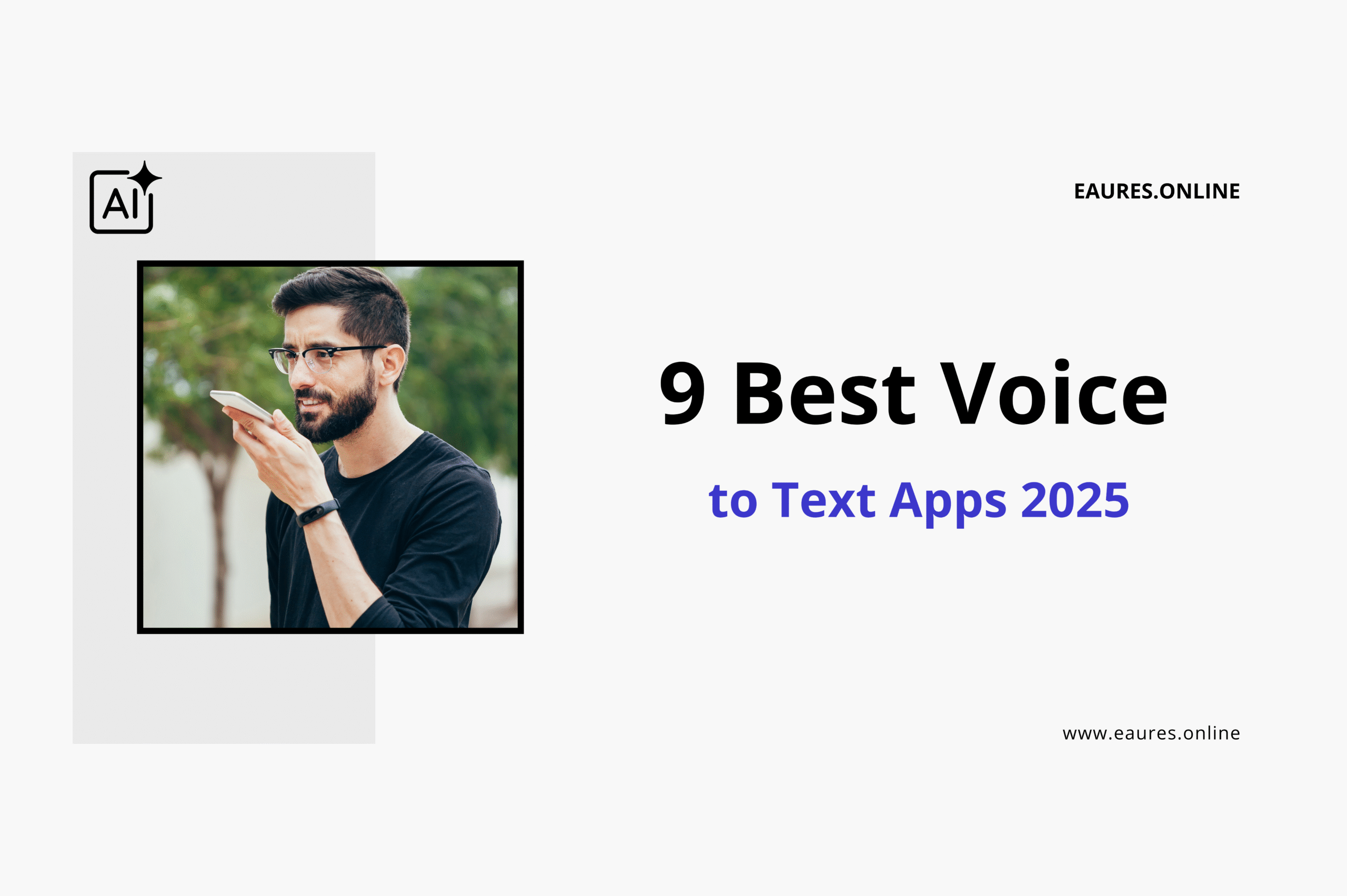Table of Contents
9 Best Voice to Text Apps 2025
Introduction: Why Voice-to-Text Apps Are Essential in 2025
In 2025, the best voice to text apps are transforming the way professionals, writers, and everyday users work. With rapid advances in artificial intelligence and speech recognition, these tools can now achieve near-perfect accuracy, handle multiple languages, and even understand tone and punctuation. Whether you’re dictating an email, transcribing interviews, or capturing meeting notes, modern voice-to-text software saves valuable time while enhancing productivity.
Voice typing is no longer a niche feature—it’s a mainstream productivity solution used by journalists, executives, students, and creators worldwide. As AI models evolve, these apps integrate seamlessly across devices and platforms, offering hands-free efficiency that was once only dreamed of.
In this comprehensive guide, we explore the 9 Best Voice to Text Apps of 2025—covering both free and premium options—to help you choose the perfect tool for your workflow.
What Makes a Great Voice to Text App?
Before diving into the list, let’s define what separates the best from the rest. A powerful voice-to-text app in 2025 should include:
- High accuracy rate with advanced AI and contextual understanding
- Multi-language support for global use
- Real-time transcription and offline capabilities
- Cross-platform availability (Windows, macOS, Android, iOS, and web)
- Integration options with productivity tools like Google Docs, Notion, or Microsoft 365
- Privacy and data security with encrypted transcription
- Custom vocabulary and smart punctuation features
These benchmarks guided our selection of the top-performing apps for this year.

1. Otter.ai – The Industry Standard for Real-Time Transcription
Otter.ai continues to dominate the space as one of the best voice to text apps in 2025. It’s especially popular among professionals, journalists, and students for its real-time meeting transcriptions and collaboration tools.
Otter uses advanced AI to identify speakers, summarize conversations, and even extract key points automatically. With integrations for Zoom, Google Meet, and Microsoft Teams, it’s perfect for anyone managing virtual meetings.
Highlights:
- Real-time transcription with speaker labels
- Live summaries and AI note generation
- Cloud syncing across devices
- Team collaboration features
Otter offers a free tier with generous limits and premium plans starting at $16.99/month.
For deeper productivity insights, you can also discover the Best AI Tools for Productivity in 2025 that complement Otter’s capabilities.
2. Google Voice Typing – The Free Powerhouse for Everyday Use
If you’re looking for a simple, free solution, Google Voice Typing is a powerful choice available directly in Google Docs or Android keyboards. It’s remarkably accurate, supporting over 125 languages and dialects.
This tool is ideal for writers, bloggers, and content creators who work inside the Google ecosystem. It automatically handles punctuation and capitalization, and since it’s integrated into Google Workspace, your work is saved in real-time.
Highlights:
- 100% free with a Google account
- No installation needed
- Excellent language support
- Great for quick dictations and emails
You can read more on TechRadar’s detailed overview of top speech-to-text apps for an external expert perspective.
3. Dragon NaturallySpeaking – The Gold Standard for Professionals
Dragon NaturallySpeaking by Nuance remains the most advanced dictation software in the market. Its deep learning algorithms adapt to your voice, accent, and even industry-specific vocabulary.
While it’s more expensive than most competitors, Dragon is favored by legal, medical, and business professionals who rely on pinpoint accuracy. Its customization options and command-based automation make it an elite choice.
Highlights:
- Up to 99% accuracy rate
- Specialized editions for medical and legal professionals
- Works offline
- Extensive voice command system
For professionals managing business communications, check out these powerful AI email prompts for sales outreach to complement Dragon’s efficiency.
4. SpeechTexter – Reliable, Free, and Web-Based
SpeechTexter is a free, browser-based voice-to-text app that’s incredibly easy to use. It supports more than 70 languages and is perfect for note-taking, essays, or writing drafts without typing.
Simply visit SpeechTexter.com and start dictating. The app works in Chrome and uses Google’s speech recognition engine for impressive accuracy.
Highlights:
- Completely free and web-based
- Multilingual support
- Real-time punctuation commands
- Custom word dictionaries
SpeechTexter’s simplicity makes it an excellent choice for students and content creators who want quick, reliable results without subscriptions.
5. Microsoft Dictate – Seamless for Windows Users
Built directly into Microsoft 365 apps, Microsoft Dictate is a voice-to-text solution that integrates with Word, Outlook, and PowerPoint. It supports real-time transcription, auto-punctuation, and hands-free editing commands.
The app leverages Microsoft’s Azure Speech Services for cloud-based accuracy. It’s especially valuable for users already embedded in the Microsoft ecosystem.
Highlights:
- Integrated into Office apps
- Excellent command controls (“bold that,” “new paragraph,” etc.)
- AI-enhanced punctuation
- Enterprise-grade security
When used with AI assistants like those in the 9 Best AI Assistants for Small Business in 2025, Microsoft Dictate can dramatically boost workflow efficiency.
6. Apple Dictation – Best for iOS and macOS Users
For Apple users, Apple Dictation provides a fast and accurate voice-to-text experience integrated across iPhones, iPads, and Macs. In 2025, the app received an upgrade with offline transcription powered by on-device intelligence, ensuring privacy and speed.
Highlights:
- Fully integrated with iOS and macOS
- Works offline for short dictations
- Secure and private processing
- Supports commands for formatting and navigation
It’s perfect for short notes, messages, and mobile productivity. If you prefer more advanced dictation control, pairing it with Siri Shortcuts amplifies its power.

7. Notta – AI-Powered Transcription with Summaries
Notta is an emerging favorite in 2025, offering automated transcription, translation, and AI-generated summaries. It’s particularly appealing for global teams needing real-time collaboration and multilingual support.
The app records meetings, uploads audio files, and generates detailed transcripts in seconds. It can even export summaries to Google Docs or Notion.
Highlights:
- Multi-language support (100+ languages)
- AI summary generation
- Cloud storage and export options
- Free plan with limited minutes
Its built-in AI engine rivals many premium competitors, making it one of the most innovative new entrants on the list.
8. Speechnotes – Lightweight and Accurate
Speechnotes offers a minimalistic design focused purely on fast, distraction-free dictation. It’s available on Android and Chrome, syncing notes easily with Google Drive.
Users appreciate its offline capabilities and simple text editing interface. For many freelancers and students, it strikes the right balance between usability and accuracy.
Highlights:
- Free with optional premium version
- Simple and intuitive interface
- Real-time dictation in 60+ languages
- Supports Bluetooth microphones
For writing-focused workflows, The Write Practice has an excellent article on speech-to-text apps for writers that includes practical use cases for Speechnotes.
9. Descript – Beyond Transcription: Audio Editing Redefined
Descript isn’t just a transcription app—it’s an AI-powered content creation tool. It converts your speech to text, allowing you to edit video or audio just by editing words in a transcript.
This innovative workflow has made Descript a top choice for podcasters, YouTubers, and marketers in 2025. It also features Overdub, an AI voice cloning system for seamless narration.
Highlights:
- Real-time transcription and text-based editing
- AI voice generation with Overdub
- Integrated video editing tools
- Collaboration and cloud syncing
You can explore Zapier’s list of top dictation software for comparisons that include Descript’s capabilities.
How to Choose the Best Voice to Text App for You
Your perfect app depends on your goals:
- Writers and bloggers: Google Voice Typing or Speechnotes for simplicity.
- Students and meeting users: Otter.ai or Notta for real-time collaboration.
- Professionals: Dragon NaturallySpeaking or Microsoft Dictate for high accuracy.
- Podcasters and creators: Descript for text-based media editing.
- Casual users: Apple Dictation or SpeechTexter for free convenience.
It’s worth experimenting with multiple options to find the balance between cost, features, and usability.
The Future of Voice Recognition in 2025 and Beyond
By 2025, speech recognition technology has achieved human-level accuracy in many scenarios, powered by transformer-based AI models. As models like GPT, Gemini, and Claude advance, voice-to-text apps will become even more contextual—understanding intent, tone, and meaning.
For an in-depth comparison of these advanced AI systems, see Claude vs ChatGPT vs Gemini vs Llama in 2025. These innovations are shaping the very engines behind the voice apps we rely on daily.
The best voice to text apps of 2025 aren’t just transcription tools—they’re intelligent companions for productivity, accessibility, and creativity. Whether you choose a premium powerhouse like Dragon or a free, accessible option like Google Voice Typing, the right app will transform how you capture ideas and communicate.
Voice-driven workflows are here to stay. By embracing these technologies now, you’re not only saving time—you’re preparing for the next wave of AI-powered productivity.
Advanced Comparison: Accuracy, Pricing & Features of 2025’s Best Voice to Text Apps
While each app on our list has unique strengths, choosing the right one often depends on your specific needs. Below, we break down the Best Voice to Text Apps across the key dimensions that matter most: accuracy, pricing, and versatility.
| App | Accuracy (Average) | Free Plan | Paid Plan Starting | Best For |
|---|---|---|---|---|
| Otter.ai | 95–98% | ✔ | $16.99/mo | Meetings & teams |
| Google Voice Typing | 94–97% | ✔ | Free | Everyday dictation |
| Dragon NaturallySpeaking | 99% | ✖ | $169 one-time | Professionals |
| SpeechTexter | 93–95% | ✔ | Free | Students & quick notes |
| Microsoft Dictate | 96–98% | ✔ | Included in 365 | Business users |
| Apple Dictation | 95–97% | ✔ | Free | Apple ecosystem |
| Notta | 94–96% | ✔ | $13.99/mo | Multilingual work |
| Speechnotes | 92–95% | ✔ | $9.99/yr | Mobile writers |
| Descript | 97–99% | ✔ | $12/mo | Podcasters & creators |
Across this landscape, Dragon NaturallySpeaking continues to lead in raw precision, while Otter.ai and Descript redefine productivity with their AI-powered summaries and text-based editing. Free users, meanwhile, will find excellent functionality in Google Voice Typing and SpeechTexter, which deliver impressive accuracy without cost barriers.

Practical Use Cases: How Voice-to-Text Apps Transform Everyday Work
Voice-to-text technology has expanded beyond simple note-taking—it’s now an integral part of modern workflows. Below are five real-world scenarios showing how the Best Voice to Text Apps streamline work across industries.
1. Content Creation and Blogging
Writers are increasingly using dictation to overcome creative blocks and write more naturally. Instead of staring at a blank screen, you can speak ideas aloud and let apps like Speechnotes or Google Voice Typing handle transcription.
This “spoken-first” writing approach often produces more conversational, engaging prose. Writers can later refine and edit their text with AI editing tools or grammar checkers for polish.
2. Business and Meeting Transcriptions
For professionals, capturing meeting notes and follow-up tasks accurately is essential. Otter.ai and Microsoft Dictate allow real-time collaboration, ensuring that teams can instantly access transcripts, highlights, and summaries.
Many users integrate these apps with CRM or project management tools—an automation trend explored further in the Best AI Tools for Productivity in 2025.
3. Academic Research and Lectures
Students and researchers benefit tremendously from voice transcription. Apps like Notta or SpeechTexter can record lectures, then generate searchable text. This saves hours of manual note-taking while preserving valuable insights verbatim.
4. Podcasting and Media Production
Descript is a game-changer for creators. By turning audio into editable text, it lets users remove filler words, generate captions, and edit audio or video without traditional timelines. Podcasters can repurpose transcripts into blog posts or newsletters effortlessly.
For a visual introduction, check the YouTube video overview of Descript’s transcription features.
5. Accessibility and Inclusion
Voice-to-text technology also promotes digital accessibility. People with mobility or visual impairments can now write, communicate, and navigate devices hands-free. Apple, Google, and Microsoft continue to prioritize inclusivity by refining voice interfaces across their ecosystems.
Accuracy and AI: How 2025’s Models Understand Human Speech
The magic behind the Best Voice to Text Apps in 2025 lies in AI language models and acoustic neural networks. Today’s systems not only recognize words but interpret context, intent, and emotional tone.
For instance, when you say, “Let’s meet next Friday,” modern systems use temporal reasoning to understand and insert correct calendar dates. Similarly, AI punctuation models analyze pauses and intonation to place commas and periods accurately.
Companies like Nuance, Google, and OpenAI have been refining deep-learning algorithms trained on millions of hours of multilingual data. As a result, real-time transcription accuracy has surpassed 98% under optimal conditions—an astounding leap from earlier generations.
Security, Privacy, and Ethical Considerations
As voice recognition becomes ubiquitous, so do privacy concerns. Many users worry about sensitive audio data being stored or analyzed without consent.
The best voice to text apps now implement strong data protection protocols:
- On-device processing: Apple Dictation and Google Voice Typing process short dictations locally, ensuring no audio leaves your device.
- End-to-end encryption: Platforms like Otter.ai use encrypted connections and strict access controls.
- User control: Services like Dragon offer full offline operation, ideal for professionals handling confidential material.
When choosing an app, always review its data retention policy and encryption standards, especially if you work with private client data or medical information.
Advanced Tips for Using Voice-to-Text Effectively
Even the best tools require some practice to unlock their full potential. Here are expert strategies to maximize your transcription quality and workflow efficiency:
- Use a high-quality microphone. Background noise can significantly impact accuracy. A dedicated USB mic or headset improves results dramatically.
- Speak clearly and consistently. Avoid mumbling or trailing off—AI models thrive on steady cadence.
- Learn voice commands. Master commands like “new line,” “delete that,” or “bold the last word” to save editing time.
- Customize vocabulary. Add names, brands, or technical terms manually if your app supports it.
- Review immediately. Always proofread your transcription soon after dictation while the context is fresh.
These small habits can boost accuracy by up to 5–10% in practical use.
Integration with Other AI Tools and Workflows
Voice-to-text software is evolving beyond standalone apps. In 2025, the most effective setups combine transcription with AI assistants, automation platforms, and content management systems.
Imagine dictating a meeting summary, automatically converting it to text with Otter.ai, and then sending a formatted report through your AI email assistant using the strategies shared in Powerful AI Email Prompts for Sales Outreach.
Or, pairing Descript with an AI writing tool like ChatGPT or Claude to polish transcripts into blog posts. These hybrid workflows represent the next era of productivity—where speech, text, and AI work together seamlessly.
For a comprehensive overview of these AI ecosystems, explore Claude vs ChatGPT vs Gemini vs Llama in 2025.
Common Challenges and How to Overcome Them
Even with high-end tools, users occasionally face transcription errors or formatting issues. Here’s how to handle the most common challenges:
Background Noise
Use directional microphones or noise-cancellation filters. Apps like Dragon and Otter.ai include built-in noise reduction for clean audio.
Technical Jargon
Enable custom vocabulary lists to teach the app domain-specific words—especially important in legal, medical, or engineering fields.
Internet Dependence
If you need offline functionality, consider Dragon NaturallySpeaking or Apple Dictation. Both offer local processing without cloud reliance.
Multilingual Switching
Apps such as Notta and SpeechTexter excel at handling multiple languages within the same session—ideal for bilingual professionals.
By applying these adjustments, you can turn occasional frustrations into a consistently smooth transcription experience.
The Broader Impact of Voice-to-Text on Communication
Beyond convenience, voice recognition technology is reshaping communication norms. We’re entering an age where spoken interaction is becoming the primary interface between humans and computers.
In 2025, voice-to-text apps are used not only for productivity but for education, journalism, therapy, and accessibility. People are discovering that speaking ideas aloud enhances creativity and memory retention.
Enterprises also benefit: businesses now analyze transcribed meeting data for AI-driven insights, surfacing decisions, and customer sentiments that were previously lost in conversation.
As this integration deepens, voice-driven AI assistants will merge with other generative tools to form a seamless ecosystem—where writing, planning, and execution begin with your voice.
Summary Table: Choosing the Right App
| Need | Recommended App | Reason |
|---|---|---|
| Business meetings | Otter.ai | Real-time summaries & collaboration |
| Long-form writing | Dragon NaturallySpeaking | Industry-leading accuracy |
| Academic lectures | Notta | AI transcription + translation |
| Quick mobile notes | SpeechTexter | Free & simple |
| Apple users | Apple Dictation | Offline & integrated |
| Multimedia creation | Descript | Audio/video editing via text |
| Budget-friendly | Google Voice Typing | Free, multilingual |
| Microsoft users | Microsoft Dictate | Built into Office 365 |
| Creative writing | Speechnotes | Distraction-free dictation |
No matter your profession, one of these tools will align with your productivity goals.

Looking Ahead: What’s Next for Voice Recognition
The next frontier in voice-to-text technology is contextual intelligence—where AI understands not just words, but meaning. Future systems will automatically detect emotions, identify action items, and format notes intelligently.
We’re also witnessing integration with wearables, smart glasses, and IoT devices, allowing instant dictation anywhere. Coupled with improved privacy frameworks and real-time translation, the technology is becoming universally accessible.
In essence, voice is fast becoming the new keyboard. The era of typing is gradually giving way to speaking, and the best voice to text apps of 2025 are leading that transformation.
Conclusion: Speak Freely, Work Smarter
Whether you’re dictating a book, managing a team meeting, or capturing creative ideas on the go, today’s voice-to-text tools offer precision, speed, and freedom.
Each app reviewed—Otter.ai, Dragon NaturallySpeaking, Descript, and others—represents a milestone in human-computer communication. Choosing the right one is about aligning your workflow, platform, and goals.
As artificial intelligence continues to evolve, your voice will remain the most natural, efficient input method of all. The tools we’ve explored here aren’t just transcription apps—they’re the gateway to a more fluid, intelligent, and creative future of work.




